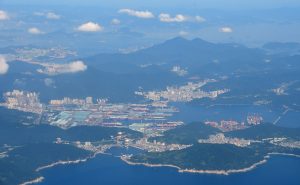With maritime and territorial disputes in Southeast Asia intensifying in recent years, we have seen countries like the Philippines, Indonesia, and Malaysia start acquiring more big-ticket naval hardware. Given that China is often the aggressor in these disputes, it makes sense that much of these modernization programs would look to other suppliers. Along with the usual players in Europe, South Korea’s big naval shipbuilders – Hyundai Heavy Industries and Daewoo Shipbuilding & Marine Engineering – have consequently seen their footprints in the region expand.
The Philippine Navy began planning and budgeting for a major upgrade of its aging fleet around 2010. This included the purchase of two amphibious landing and transport ships under a 2014 contract worth $92 million with Indonesia’s state-owned shipbuilder PT PAL.
But the big acquisition so far has been a pair of guided missile frigates built by Hyundai Heavy Industries for 16 billion Philippine pesos (roughly $311 million). The first ship, the Jose Rizal, was commissioned in 2020. Despite some haggling over the weapons systems, the Philippines was apparently happy with the outcome and signed another deal with Hyundai Heavy Industries in December 2021 for a pair of corvettes with a $554 million price tag.
One of the main reasons the Philippines may be sticking with Hyundai Heavy Industries is because a single contractor can deliver ships that are all compatible across a range of systems. If you buy ships piecemeal from different suppliers, on the other hand, it may not be possible to integrate a single weapons control system across them all. Interestingly, this piecemeal approach is precisely the one being employed by Indonesia.
Indonesia is in the midst of a naval modernization program, which also kicked off about a decade ago. And like in the Philippines, South Korean shipbuilders have been major players. Indonesia’s acquisition strategy is somewhat different, however. They aren’t necessarily interested in the most competitive bids, but are instead looking for the best overall deals that include some technology transfers and acquisition of indigenous production capabilities.
All of the Philippine ships were built by Hyundai Heavy Industries in South Korea. When Indonesia does deals, it’s lately been looking to boost its domestic defense-industrial complex, and in particular make PAL into a regional manufacturing and export hub. South Korea, whose defense manufacturing ties with Indonesia go back several decades, has been a very accommodating partner in this respect.
The amphibious transport ships that PAL built for the Philippines actually began with a $150 million deal struck with South Korea’s Daesun back in 2004. The first two ships were designed and built in South Korea, then PAL built the final two at its shipyard in Surabaya. Could Indonesia have bought these ships for less money from a different contractor? Maybe. But by doing it this way PAL acquired the ability to build them domestically, and it enabled them down the road to indigenously produce a pair for export to the Philippines.
A similar strategy was employed in Indonesia’s submarine deal with Daewoo. In 2011, Daewoo agreed to supply Indonesia with three submarines for $1.1 billion. The first two were built in South Korea, and the final one by PAL in Surabaya. They have pursued similar deals with European companies for the acquisition of new frigates. Because they have been sourcing these ships from a variety of contractors, they may run into systems integration issues at some point, but that appears to be a trade-off Indonesia’s defense planners are willing to live with.
Malaysia’s naval modernization, as I detailed in this piece last year, has been a bit bumpier. Under license from French shipbuilder DCNS the country’s government undertook to build six littoral combat ships at Boustead Naval Shipyard in Perak, but the program has been plagued by delays and cost overruns and the first ship is not expected to be commissioned until 2026. It also initially engaged China Shipbuilding and Offshore International to provide four littoral mission ships, the final two of which would be constructed in Malaysia. It was eventually decided all four ships would be built in China.
This is only a small cross-section of the naval modernization efforts underway in the region. But it seems clear that South Korea’s big shipbuilders are forging and consolidating long-term ties with important maritime players in Southeast Asia, moving into a primary supplier role for the Philippine Navy while helping Indonesia’s PAL to acquire indigenous production capabilities based on South Korean designs and technology. China’s role in Malaysia’s naval procurement, on the other hand, appears to hold less obvious long-term strategic value and did not result in any production being moved to Malaysia. If we are indeed on the cusp of a big naval arms build-up in the coming years, this dynamic could prove to be an important one.

































